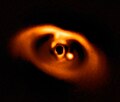| Observation data Epoch J2000 Equinox J2000 | |
|---|---|
| Constellation | Lyra [1] |
| Right ascension | 19h 09m 26.8350s [2] |
| Declination | +38° 42′ 50.456″ [2] |
| Apparent magnitude (V) | 8.25 [3] |
| Characteristics | |
| Evolutionary stage | subgiant [4] |
| Spectral type | F6 IV [4] |
| Apparent magnitude (J) | 7.229±0.032 [5] |
| Apparent magnitude (H) | 7.031±0.023 [5] |
| Apparent magnitude (K) | 6.945±0.018 [5] |
| Variable type | Planetary transit variable [4] |
| Astrometry | |
| Radial velocity (Rv) | −18.174±0.005 [6] km/s |
| Proper motion (μ) | RA: 28.093(18) mas/yr [2] Dec.: 28.546(20) mas/yr [2] |
| Parallax (π) | 9.2181±0.0173 mas [2] |
| Distance | 353.8 ± 0.7 ly (108.5 ± 0.2 pc) |
| Absolute magnitude (MV) | 2.99 [7] |
| Position (relative to Kepler-21A) [8] | |
| Component | Kepler-21B |
| Epoch of observation | 2014 |
| Angular distance | 0.7671(62) ″ |
| Position angle | 129.74(46)° |
| Projected separation | 87 AU |
| Details [9] | |
| Mass | 1.408+0.021 −0.030 M☉ |
| Radius | 1.902+0.018 −0.012 R☉ |
| Luminosity | 5.188+0.142 −0.128 L☉ |
| Surface gravity (log g) | 4.026±0.004 cgs |
| Temperature | 6,305±50 K |
| Metallicity [Fe/H] | −0.03±0.10 dex |
| Rotation | 12.62±0.03 d [3] |
| Rotational velocity (v sin i) | 8.4±0.5 [3] km/s |
| Age | 2.60±0.16 Gyr |
| Other designations | |
| HD 179070, HIP 94112, KOI-975, KIC 3632418, TYC 3120-963-1, 2MASS J19092683+3842505 [10] | |
| Database references | |
| SIMBAD | data |
Kepler-21, also known as HD 179070, is a star with a closely orbiting exoplanet in the northern constellation of Lyra. At an apparent visual magnitude of 8.25 this was the brightest star observed by the Kepler spacecraft to host a validated planet until the discovery of an exoplanet orbiting HD 212657 in 2018. [3] [11] This system is located at a distance of 354 light-years (109 parsecs ) from the Sun based on parallax measurements, but is drifting closer with a radial velocity of −18.2 km/s. [6]

The spectrum of HD 179070 presents as an evolving F-type subgiant star with a stellar classification of F6 IV. [4] This suggests the star has exhausted the supply of hydrogen at its core and is evolving into a giant star. It is an estimated 2.6 [9] billion years old and is spinning with a rotation period of 12.6 days. [3] With 1.4 times the mass of the Sun it currently has 1.9 times the Sun's radius. The star is radiating five times the luminosity of the Sun from its photosphere at an effective temperature of 6,305 K. [9]
A faint nearby source was detected in 2011 and determined to be a co-moving stellar companion in 2016. Designated HD 179070 B, it lies at an angular separation of 0.75″ along a position angle of 129° relative to the primary. At the distance of this star, this corresponds to a projected separation of 87 AU . It is possible that this companion star had a significant influence on the exoplanet formation and subsequent orbital evolution. [8]

